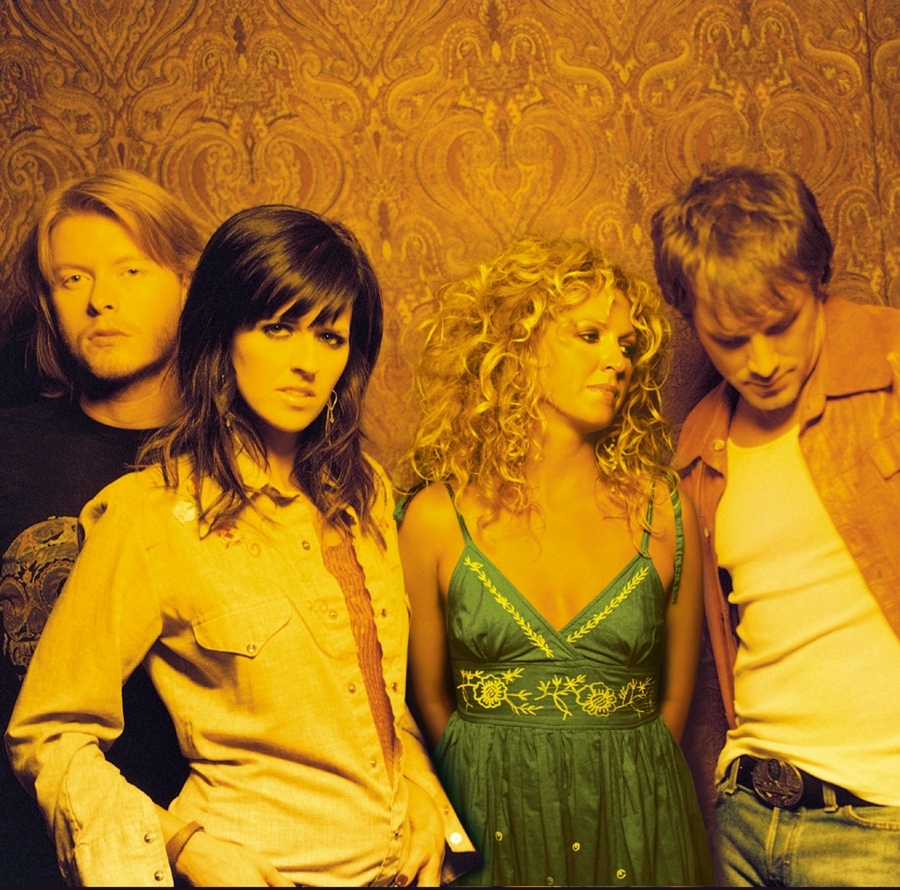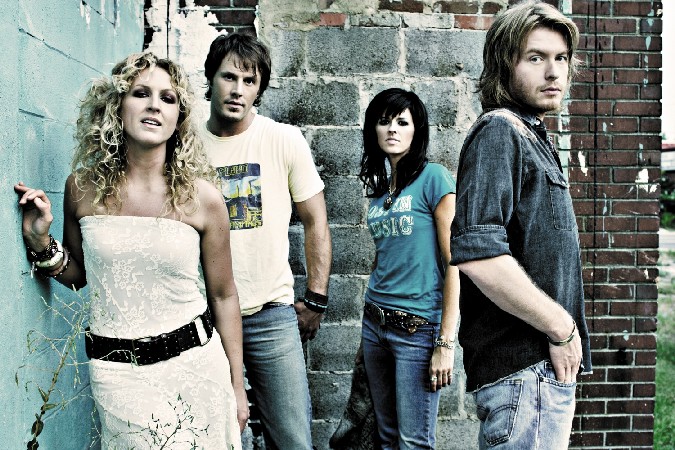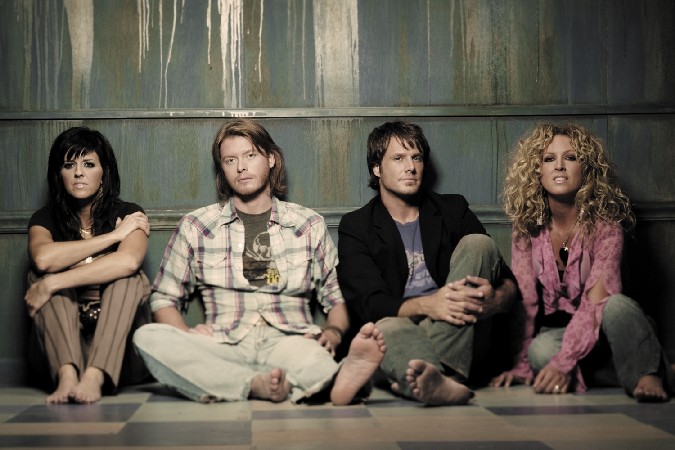

PopEntertainment.com
>
Feature Interviews - Music >
Feature Interviews K to O >
Little Big Town (2006 Interview)
 Little Big Town
Little Big Town
Four Distinct Voices in Perfect Harmony
By Mark Mussari
Copyright ©2006 PopEntertainment.com. All
rights reserved.
Posted:
June 20, 2006.
As a vocal group Little
Big Town exists on a rarified plane. The country-rock quartet—whose album
The Road to Here has already sold over 500,000 copies and spawned a
mega-hit in the stomping Southern anthem “Boondocks”—consists of two
women and two men. That would be singular enough in the country field,
but all four members of this powerhouse group, who also write much of
their own music, sing lead.
And I mean sing:
Karen Fairchild, Kimberly Roads, Jimi Westbrook and Phillip Sweet blend
their four distinctive styles into an intricate tapestry of sound that
seems to defy categorization. Fairchild’s edgy alto grabs you by the
collar; Roads’ emotional soprano features a genuine mountain twang;
Westbrook’s Southern tenor is aggressive and expressive; and Sweet’s husky
baritone reveals r & b tinges.
Westbrook points out
that the group’s male-female combination offers more variety and emotional
depth. “Other groups don’t have that dynamic,” he explains, “so it’s
something that sets us apart.” In the case of the intricate and
imagery-laden “Mean Streak,” Fairchild describes the writing process that
led to a female lead: “When we started writing that one, we didn’t know
who—or what gender—would be delivering the lyric. Yet, it takes on its
own life when you hear a woman sing it. It’s one of those moments that
show the depth of emotion in a female voice.” On that number the lead
fell to her cohort, Kimberly Roads.
The four singers
seamlessly trade leads, often within a number, and then shift into some of
the tightest harmony in any genre of music. “A lot of it is in the
harmony structure,” Westbrook adds. “It’s a natural thing involving where
our voices land—we’re always looking for that buzz.” Their immediately
identifiable sound also stems from their dark tone, as in the
Crosby, Stills, Nash & Young-inspired “Bones.” “It
happens naturally with the configuration of our voices,” comments
Fairchild.
 Threads of influences
weave in and out of Little Big Town’s music: a lick from the Allman
Brothers here, a riff from Pure Prairie League there. The darkness of
their sound echoes early Eagles or Fleetwood Mac in its heyday.
Fairchild observes: “When you look at the
bands of the seventies who have influenced us, they had immediately
identifiable harmonies. If Glenn Frey or Don Henley was singing lead in
the Eagles, it didn’t matter. When it got to the chorus you knew it was
the Eagles. That’s what we’re setting out to do”
Threads of influences
weave in and out of Little Big Town’s music: a lick from the Allman
Brothers here, a riff from Pure Prairie League there. The darkness of
their sound echoes early Eagles or Fleetwood Mac in its heyday.
Fairchild observes: “When you look at the
bands of the seventies who have influenced us, they had immediately
identifiable harmonies. If Glenn Frey or Don Henley was singing lead in
the Eagles, it didn’t matter. When it got to the chorus you knew it was
the Eagles. That’s what we’re setting out to do”
As lyricists, the band
discloses a pictorial nature with plenty of images and provocative
similes. Fairchild’s rich alto is featured on the album’s third single,
the haunting and driving “Good as Gone.” “It’s such a visual song,” she
says. “When you listen to that one, you envision the moment.” Westbrook
adds that all four band members “have that love of the lyric—we try to
paint a picture.” He sees the songs on The Road to Here as a
“movie” appearing in the listener’s mind.
In reality almost nothing has been easy on the road to here for
the multi-talented quartet. Their inception seemed auspicious enough:
they debuted on the stage of the legendary Grand Ole Opry in 1999. Yet,
despite two minor hits (“Don’t Waste My Time” and “Everything Changes”),
their first self-titled CD, released in 2002, fizzled quickly, resulting
in the group being dropped by its first label.
Still, the four singers
would not give up: taking odd jobs to support themselves, they continued
to tour—often losing money in the process. Westbrook recalls: “The four
of us would climb into a van and drive all over the country, just for gas
money. It all came down to one thing: Just let us get in front of people
and do what we do. Just let us take our music to them. That was the
ultimate goal.”
Personal tragedies then
imposed themselves on the group, including two divorces and, in 2005, the
untimely death of Roads’ 41-year old husband to a heart attack. They
remained undeterred. The band found a mentor in songwriter-producer Wayne
Kirkpatrick, who had co-written a rousing number, “Pontiac,” with the
group on their first CD.
Believing in the
quartet’s undeniable talent, Kirkpatrick—who also co-wrote many of the
songs on The Road to Here—paid for new sessions until the band
could find a record deal. He also convinced some of the most revered
musicians in country to contribute to The Road to Here, including
Jerry Douglas on dobro and Gordon Kennedy on guitar. The band then signed
with the independent label Equity and, in 2005, re-burst onto the music
scene with the rollicking “Boondocks” (written by the band and
Kirkpatrick).
 A down-home thumper
that features a riveting opening vocal by Westbrook and some infectious
dobro work by Douglas, “Boondocks” became a top-ten country hit and
achieved an RIAA Gold Certification for digital sales in excess of
100,000. The video for “Boondocks” soon hit #1 on CMT’s Top 20
Countdown—as did the CD’s second release, “Bring It on Home,” a pensive
ballad that features Sweet’s soulful baritone on lead. The rest of
The Road to Here runs the gamut from the insistent “Looking for a
Reason” to the bluegrassy “Wounded” to the wistful closer, the layered
lament “Stay.”
A down-home thumper
that features a riveting opening vocal by Westbrook and some infectious
dobro work by Douglas, “Boondocks” became a top-ten country hit and
achieved an RIAA Gold Certification for digital sales in excess of
100,000. The video for “Boondocks” soon hit #1 on CMT’s Top 20
Countdown—as did the CD’s second release, “Bring It on Home,” a pensive
ballad that features Sweet’s soulful baritone on lead. The rest of
The Road to Here runs the gamut from the insistent “Looking for a
Reason” to the bluegrassy “Wounded” to the wistful closer, the layered
lament “Stay.”
In the spring of 2006,
the band toured with both country superstar Keith Urban and rock legend
John Mellencamp. Every night in his show, Mellencamp called the band out
to sing “Pink Houses” with him. “It’s one of those moments you
want to check off on a list of dreams,” says Westbrook. “Standing on
stage in the middle of that, we would just look at each other, shake our
heads and wonder: How did we get here?”
Hearing Little Big Town
sing, it’s really no wonder at all.
CLICK HERE TO SEE WHAT LITTLE BIG TOWN HAD
TO SAY TO US IN 2007!